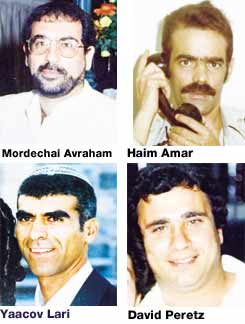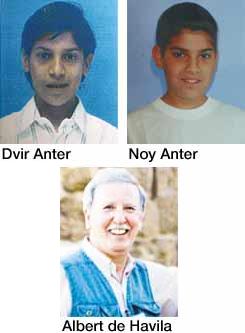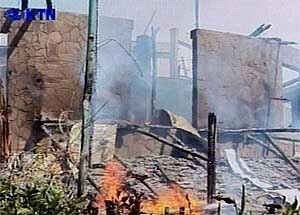| <<
Nov 27| HISTORY “4” “2”DAY
|Nov 29
>> Events, deaths, births, of NOV 28 [For Nov 28 Julian go to Gregorian date: 1582~1699: Dec 08 — 1700s: Dec 09 — 1800s: Dec 10 — 1900~2099: Dec 11] |
| 1997 Online music retailer CDNow files for an IPO, saying
that it will use the proceeds to enhance strategic relationships with Yahoo
and Excite, two Internet directories to which CDNow pays fees for referrals
of customers who purchased CDs on-line. CDNow's rival N2K had gone public
the previous month. CDNow was founded in 1994 and became the largest music
distributor on the Web. 1994 Noruega rechaza su integración en la Unión Europea, mediante referéndum. 1993 British officials confirm that they have made secret contacts with the outlawed Irish Republican Army in an effort to end the violence in Northern Ireland. 1993 Carlos Roberto Reina is elected president of Honduras. 1992 a fire destroys parts of the Hofburg Palace in Vienna, Austria, threatening the famous Lipizzaner stallions. 1991 El presidente de Togo, Etienne Gnassingbe Eyadema, detiene el golpe de Estado y restablece la normalidad con la creación de un Gobierno de unión nacional. 1990 Margaret Thatcher resigned as prime minister of Britain during an audience with Queen Elizabeth II, who conferred the premiership on John Major. — John Major es elegido primer ministro del Reino Unido por el Partido Conservador, en sustitución de Margaret Thatcher.
|
1985 The Irish Senate approved the Anglo-Irish accord concerning Northern Ireland. 1984 Pope John Paul II completes the last of 133 homilies in St. Peter's Square on the theme, "Theology of the Mystical Body." It was the first time in public catechesis that a pope made use of higher criticism of the Old Testament and freely cited a number of Protestant theologians. 1984 Republican Robert Dole is elected US Senate majority leader. 1983 El escritor granadino Francisco Ayala gana el Premio Nacional de Literatura por su obra Recuerdo y olvidos. 1982 Representatives from 88 nations gather in Geneva to discuss trade. They would develop a plan for the eradication of protectionist trade policies. 1982 El Papa Juan Pablo II erige al Opus Dei en Prelatura personal y nombra prelado al español Álvaro del Portillo y Diez de Sollano. 1979 Fracasa el atentado contra Edward Moore Kennedy. 1971 Juan María Bordaberry, candidato del Partido Colorado, gana las elecciones presidenciales en Uruguay, celebradas en estado de excepción. 1971 The Anglican Church ordains its first two female priests. 1967 El FNL proclama la independencia de la República Popular de Yemen del Sur, con la aprobación de las autoridades británicas. 1966 Coup in Burundi overthrows monarchy; a republic is declared 1966 La nueva Constitución de la República Dominicana declara el país Estado libre e independiente. 1965 El presidente estadounidense Lyndon Baines Johnson designa esta jornada "día de la oración nacional", en memoria de las víctimas de la Guerra de Vietnam. 1964 The US launched the space probe Mariner 4 on a course to Mars.
|
| 1960 Mauritania gains independence from France (National
Day) 1960 Los estudiantes comunistas protagonizan en Caracas una revuelta contra el gobierno de Romulo Betancourt. 1958 Chad becomes an autonomous republic within the French Community 1958 Congo and Mauritania become autonomous members of French Community 1958 The US fires an intercontinental ballistic missile at full range for the first time. 1950 In Korea, 200'000 Communist troops launch attack on UN forces. 1950 A constitutional convention (comprised of 14 Protestant, Anglican, and Eastern Orthodox denominations) met in Cleveland, Ohio, and brought into being the National Council of the Churches of Christ in the United States of America. Today, the NCCC serves to administer disaster relief, strengthen family life, provide leadership training, and promote world peace. 1948 Dr. Edwin Land's first Polaroid cameras go on sale in Boston. 1946 Dimite el gobierno francés de Georges Bidault. 1944 The first shipment of supplies reach Antwerp by convoy, a new route for the advancing Allies.
1939 The Soviet Union denounces its nonaggression pact with Finland, which it is preparing to attack to take away by force the territories that it has been demanding.. 1937 Spanish insurgent leader Francisco Franco blockades the Spanish coast. 1935 The German Reich declares all men ages 18 to 45 as army reservists. 1934 El diputado conservador Winston Leonard Spencer Churchill presenta en la Cámara de los Comunes del Reino Unido un proyecto para incrementar la fuerza del arma aérea. 1929 Adm Richard E Byrd makes 1st South Pole flight 1922 Capt Cyril Turner (RAF) gave 1st skywriting exhibition (NYC). Turner spelled out "Hello USA. Call Vanderbilt 7200." 47'000 called 1921 Ascension of 'Abdu'l-Bah (Baha'i festival — Qawl 6, 78) 1919 US-born Nancy Astor, becomes the first woman ever elected to the UK's House of Commons, with a substantial majority she takes the Unionist seat of her husband, Waldorf Astor, who is moving to an inherited seat in the House of Lords. |
1904 El ejército colonial alemán vence a los hotentotes en Warmbad. 1899 The British are victorious over the Boers at Modder River. 1885 La reina viuda de Alfonso XII, María Cristina de Habsburgo, jura fidelidad al heredero de la Corona y a la Constitución. 1872 The Modoc War of 1872-73 begins in northern California when fighting breaks out between Modoc Chief Captain Jack and a cavalry detail led by Captain James Jackson. 1871 Ku Klux Klan trials began in Federal District Court in SC 1868 Mt. Etna in Sicily violently erupts. 1864 Rosser's Raid on New Creek (Keyser), West Virginia 1863 Thanksgiving is first observed as a regular American holiday. Proclaimed by President Lincoln the previous month, it was declared that the event would be observed annually, on the fourth Thursday in November. 1863 Mine Run Campaign continues in Virginia 1862 Engagement at Cane Hill, Arkansas 1863 Siege of Knoxville, Tennessee continues 1861 The Confederate Congress admits Missouri to the Confederacy, although Missouri has not yet seceded from the Union. 1848 La ciudad suiza de Berna es reconocida como capital única de la Confederación Helvética. 1821 Panamá declara su independencia de España. 1795 US pays $800'000 and a frigate as tribute to Algiers and Tunis. 1779 El coronel Matías de Gálvez ataca a los ingleses del territorio nicaragüense de Mosquitia.
|
|
|||||||||||||||||
1443 Le prince chrétien Skanderbeg proclame la principauté libre d’Albanie à Kroya. 1942 US government announcing coffee rationing because of the war. |
 Deaths
which occurred on a 28 November: Deaths
which occurred on a 28 November: 2002 Abbas Atras, 4, shot in the stomach by an Israeli bullet as he stood near a window in his house in Abu Sneine00, hilltop neighborhood of Hebron, West Bank. The Israeli occupiers were enforcing a curfew and said they fired when an explosive device was thrown at them, shrapnel of which they claim hit the child. 2002 Haim Amar, 56; David Peretz, 48; Mordechai “Moti” Avraham, 44; and Yaakov Lari, 35; Shaul Zilberstein, 36, one other Israeli; and two gunmen of the Al-Aqsa Martyrs Brigade, at 15:20, in the Beit She'an, Israel, bus station 50 meters from Likud party office, where voting was going on, as throughout Israel (46% of Likud members would vote, re-electing Prime Minister Ariel Sharon as party leader with 56% of the vote, to 40% foc even more hawkish challenger Benjamin Netanyahu, and 3.5% for Moshe Feiglin). Starting in the bus station, the terrorists throw a couple of hand grenades and spray bystanders with hundreds of automatic gun bullets. Silberstein was the guard at the entrance of the Likud offices. The gunmen are shot by Eran David, a Border Police officer who lives next door to the Likud branch. Some 30 persons are injured. The Reuters body count of the al-Aqsa intifada is now “at least” 1686 Palestinians and 668 Israelis.  2002::
Dvir Anter, 13, Noy Anter [23 Nov 1990–], Albert
de Havila, 66; dancers Kafedha Masha, Margaret Matin, Jaraya,
Safari (a Muslim) and his (pagan) brother Charo; their
(pagan) niece, receptionist Rizikizio; 4 other Kenyans, and three
suicide bombers, at 08:40 (06:40 UT) in the reception area of the
Israeli owned and operated Paradise Hotel at Kikambala beach, Kenya, where
the 5 Kenyan tribal dancers from village Msumarini were entertaining a group
of arriving Israeli tourists, 2002::
Dvir Anter, 13, Noy Anter [23 Nov 1990–], Albert
de Havila, 66; dancers Kafedha Masha, Margaret Matin, Jaraya,
Safari (a Muslim) and his (pagan) brother Charo; their
(pagan) niece, receptionist Rizikizio; 4 other Kenyans, and three
suicide bombers, at 08:40 (06:40 UT) in the reception area of the
Israeli owned and operated Paradise Hotel at Kikambala beach, Kenya, where
the 5 Kenyan tribal dancers from village Msumarini were entertaining a group
of arriving Israeli tourists,  including
the
Anter brothers from West Bank enclave settlement Ariel, and de Havila
from Ra'anana. Some 80 persons are injured. The hotel and some adjoining
houses are gutted by the ensuing fire. [photo >] An all-terrain
vehicle had rammed through a gate outside the hotel and into the lobby,
one man got out, ran into the reception area and set off an explosion, killing
himself. The other two bombers stayed in the vehicle, which exploded. At
about the same time, in what is believed to be a coordinated attack by Al-Qaeda
(which on 07 August 1998 had killed 224 persons at the US embassies in Nairobi
and in Dar es Salaam), light plane circling over the hotel dropped three
package-bombs (one landed in the pool, one on the roof and one in the ocean);
and, a few minutes earlier, 25 km to the south, 2 km north of Mombasa airport,
two Russian SA-7 shoulder-fired missiles barely missed (harmlessly) an Israeli
Boeing 757 of the Arkia charter company, which was taking off bound for
Tel Aviv. including
the
Anter brothers from West Bank enclave settlement Ariel, and de Havila
from Ra'anana. Some 80 persons are injured. The hotel and some adjoining
houses are gutted by the ensuing fire. [photo >] An all-terrain
vehicle had rammed through a gate outside the hotel and into the lobby,
one man got out, ran into the reception area and set off an explosion, killing
himself. The other two bombers stayed in the vehicle, which exploded. At
about the same time, in what is believed to be a coordinated attack by Al-Qaeda
(which on 07 August 1998 had killed 224 persons at the US embassies in Nairobi
and in Dar es Salaam), light plane circling over the hotel dropped three
package-bombs (one landed in the pool, one on the roof and one in the ocean);
and, a few minutes earlier, 25 km to the south, 2 km north of Mombasa airport,
two Russian SA-7 shoulder-fired missiles barely missed (harmlessly) an Israeli
Boeing 757 of the Arkia charter company, which was taking off bound for
Tel Aviv.2001 Andreas Plack, 23, in an orchard by the Bolzano-Merano highway in Italy. He had bought one-billion-lire permanent-disability insurance from his cousin, insurance agent Christian Kleon, 29, who, in accordance with their scheme, cuts open his left leg at the knee with a chainsaw. To make it look like a crime, Kleon then flees the scene and throws the chainsaw into the nearby Adige River. Plack, a part-time bouncer who wanted to become a private detective, was a first aid expert and the pair believed that he would be able to stem the bleeding before calling 113 (the Italian equivalent of the US's 911) on his cell phone. But the cut had severed the main tibia artery and vein, and when he phoned for an ambulance his voice was so distorted by pain operators could not understand where he was. Kleon is arrested on 30 November 2001, charged with murder and insurance fraud. [ photos below: Christian Kleon / the chain-saw
/ Andreas Plack]  
 |
1994 Vicente Enrique y Tarancón, cardenal español.
1987 Choh Hao Li, 74, bio-chemist prof (isolated growth hormones) 1987: 159 in crash of a South African Airways Boeing 747 in Mauritius. 1979: 257 in Antarctica crash of Air New Zealand DC-10 on sightseeing tour. An incorrect computer-stored flight plan leads to a navigational error which brings the plane near Mt. Erebus into which it crashes in whiteout conditions. 1971 Wasfi Tal Jordan's PM, assassinated in Cairo 1968 Delsarte, mathematician. 1968 Leonard Roth, mathematician. 1962 Guillermina, reina de Holanda.
1943 Eduard Helly, mathematician. 1942: 492 die from a fire that destroys Coconut Grove nightclub in Boston. Most victims suffocate or are trampled to death. 1939 James A Naismith, 78, creator of basketball. 1936 Pedro Muñoz Seca, dramaturgo español, fusilado en Paracuellos del Jarama (Madrid).. 1921 Abdu'l Baha, in Haifa, Palestine, son of Baha'u'llah (12 Nov 1817 – 29 May 1892) the Prophet-Founder of the Baha'i Faith (day celebrated by the Baha'is) 1907 Stanislas Wyspianskiy, Polish artist born on 15 January 1869. 1886 Joseph Urbain Mélin, French artist born on 14 February 1814. 1877 François Diday, Swiss artist born on 112 February 1802. 1870 Jean Frédéric Bazille, French Impressionist painter born on 06 December 1841. — MORE ON BAZILLE AT ART “4” NOVEMBER with links to images. 1862 Charles Ferdinand Wimar, US artist born on 20 February 1828. — MORE ON WIMAR AT ART “4” NOVEMBER with links to images.
1827 Dov Baer Schneersohn Lubavitch leader/author (Imirei Binah) 1822 Francisco Antonio Zea Díaz, naturalista, político y escritor colombiano. 1811 Johann-Baptist Drechsler, Austrian artist born in 1756. — Blumenstück 1763 Domingo Pantaleón Álvarez de Abreu, religioso español. 1729 Most of the 300 French settlers and soldiers at Fort Rosalie, Louisiana, massacred by Natchez Indians. 1680 Gian Lorenzo Bernini, Italy, greatest Baroque sculptor in Italy, also an architect, painter, and dramatist, the last of Italy's remarkable series of universal geniuses. He was born on 07 December 1598. — MORE ON BERNINI AT ART “4” NOVEMBER with links to images. 1652 (burial) Bartholomeus van Bassen, Dutch artist born in 1590. — MORE ON VAN BASSEN AT ART “4” NOVEMBER with links to images. 1262 Shinran founder of Japan's True Pure Land Buddhist sect 0741 St Gregory III, Pope |
| Births
which occurred on a 28 November: 1950 Russell Allan Hulse, físico estadounidense. 1944 Rita Mae Brown, novelist. 1940 Ramón Masip Argilaga, empresario español. 1936 Gary Hart (Sen-D-Colo). presidential candidate. 1931 María Victoria Atencia, poetisa y traductora española. 1930 La rebelión de las masas de José Ortega y Gasset se publica. 1924 La montaña mágica, novela del alemán Thomas Mann, se publica. 1916 Vyes Theriault, French-Canadian author. 1912 Eugenio Fernández Granell, pintor y escritor español. 1908 Claude Levi-Strauss, ethnologue, auteur de Tristes tropiques et père du structuralisme, à Bruxelles — social anthropologist (Structure Anthropologique) 1907 Alberto Moravia, Italian novelist (Indifferent Ones, The Conformist, Conjugal Love).
1881 Stefan Zweig Vienna Austria, poet/essayist/dramatist (Beware of Pity) 1862 Théodore van Rysselbergue, Belgian artist who died on 13 December 1926. 1862 Albert Gabriel Rigolot, French artist who died on 25 April 1932. 1857 Alfonso XII, rey de España. 1856 Belisario Porras, estadista y escritor panameño. 1851 Hugo Darnaut, Austrian artist who died in 1937. 1847 Taro Katsura, 11th, 13th, and 15th Prime Minister of Japan (02Jun1901-07Jan1906, 14Jul1908-30Aug1911, 21Dec1912-20Feb1913), born in Yamaguchi Prefecture. He died on 10 October 1913. 1837 John Hyatt, inventor of celluloid.
|
|||||
| 1821 Nikolai Nekrasov Russia, poet/journalist (Who Can
be Happy in Russia?) 1820 Friedrich Engels Germany, social philosopher; Marx's collaborator — Friedrich Engels est né à Barmen, en Rhénanie, le 28 novembre 1820. 1805 John Stephens US archeologist; founded study of Central America. 1800 Willem de Klerk, Dutch artist who died in 1874.
1632 Jean-Baptiste Lully Florence Italy, composer (Bellerophen) 1631 Abraham Brueghel Ringraaf, Flemish artist who died in 1690.
|
|||||||||||